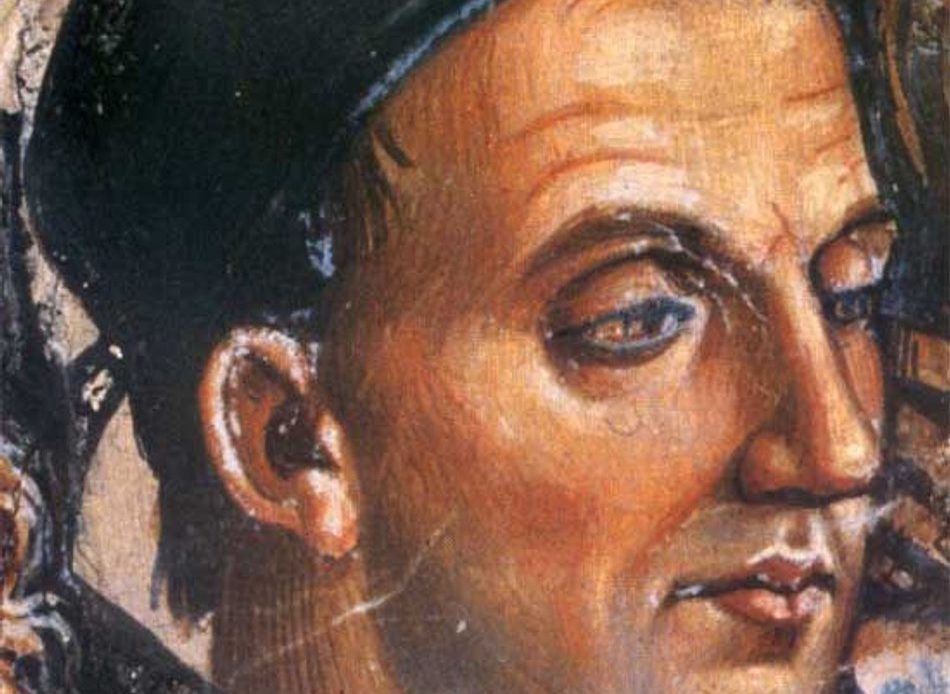One of the last representatives of the gothic style of the Florentine school: Who is Fra Angelico?
The artist was accepted as a holy person by Pope John Paul II on October 8, 1982. This was the culmination of the appreciation given to Angelico's work, which emerged with its simplicity and the power of the colors used (white, blue, gold, red), examining everything, worldly concerns, simple joys, everyday behavior or mystical ecstasies, in the light of the other world.

Giorgio Vasari, the first art historian of Italian art, dates the birth of Guido or Guidolini di Pietro, later known as Fra Angelico, to 1387: indeed, he states that the artist was 66 years old at the time of his death in 1455.
However, contemporary critics have made this date of birth, which no document can confirm, a matter of debate: Accordingly, the painter should have been born around 1400, or at the latest around 1402, in Vicchio di Mugello, a small city close to Florence.
The first document showing the activity of the painter (dipintore) is dated 1417; During this period, Angelico still had a secular personality. There is no definitive information about the education he received. However, we have many clues that he was engaged in miniature painting, and art historians think that he was a student of Lorenzo Monaco, one of the last representatives of the gothic style of the Florentine school, and a monk, as his surname indicates.
Fra Angelico (1395 – 18 February 1455) was a Dominican friar and Italian painter of the Early Renaissance, described by Giorgio Vasari in his Lives of the Artists as having "a rare and perfect talent". He earned his reputation primarily for the series of frescoes he made for his own friary, San Marco, in Florence, then worked in Rome and other cities. All his known work is on religious subjects.
Angelico's many altarpieces show traces of miniature art, especially in the sense of modeling, placement of characters, and guilloche, such as sky blue—Angelico blue—or gold-inlaid background. A book of miesa (the book of church prayers in Catholics), whose date can be determined and attributed to him, seems to prove that Angelico continued to decorate books with the art of illumination in 1430.
Between 1420 and 1422, Guido di Pletro became a monk at the Monastery of San Domenic in Fiesole, under the reformed branch of the Dominican order that advocated a return to the original strict rules of Christianity. The monk took the name "Fra Giovanni da Fiesole" and undoubtedly received an extremely strong religious education under the direct direction of St. Antoninus, the abbot of the monastery to which he belonged and the leading figure of religious teaching in the Quattrocento.
His education probably continued until 1425-1429, the period when the first developments in his artistic activity appeared: in particular, he painted a large number of altarpieces.
The altar back in Fiesole (1426) and the painting The Martyrdom of the Three-winged St. Peter (1429) constitute examples of the "ordo gotico" (a kind of church calendar showing daily worship in the Gothic style), which was still in line with Monaco's teaching at that time.
In the years that followed, the development of his style became very evident, and, temporarily, the influence of Masolino da Panicale or Gentile da Fabriano was visible.
In 1436, thanks to the intervention of the ruler of Florence, Cosimo de Medici, and his brother Lorenzo, Pope Eugenius IV Fiesole handed over to the Dominicans the Florentine buildings of the Monastery of San Marco, which were in ruins at that time. Michelozzo, an architect and sculptor (who would later create the Medici Palace), was tasked with the restoration of the buildings; All painting decorations were left to Angelico. Taken parallel to each other; These two works started in 1438 and lasted until 1452.
Together with his workshop, Angelico executed the work, which constitutes one of the pinnacles of fresco art, in this meditation-oriented place (outside the church, consisting of 44 cells, a seclusion room, a library, and a priest's room). Nearly three-quarters of the works created to facilitate the monks' immersion in religious thought represent scenes of the love of Jesus.
Although Fra Angelico remained a modest and religious person throughout his life, he achieved great success from a very early period: in a document dated 1447 he was mentioned as «one of the most famous Italian painters».
The fact that Paul Delaroche, the professor of the School of Fine Arts, placed the image of Fra Angelico in the foreground in the enormous composition he created to decorate the school's amphitheater, which was a kind of homage to the masters of the past, dates back to the 19th century. It proves that Angelico's teaching is still valid in the century.
The artist was accepted as a holy person by Pope John Paul II on October 8, 1982. This was the culmination of the appreciation of Angelico's work, which emerged with its simplicity and the power of the colors used (white, blue, gold, red), examining everything, worldly concerns, simple joys, everyday behavior, or mystical ecstasies, in the light of the other world.
